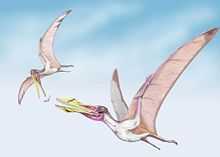Cimoliopterus
| Cimoliopterus Temporal range: Early Cretaceous, 112Ma | |
|---|---|
 | |
| Holotype | |
| Scientific classification | |
| Kingdom: | Animalia |
| Phylum: | Chordata |
| Order: | †Pterosauria |
| Clade: | †Caelidracones |
| Suborder: | †Pterodactyloidea |
| Genus: | †Cimoliopterus Rodrigues & Kellner, 2013 |
| Type species | |
| †Pterodactylus cuvieri Bowerbank, 1851 | |
| Species | |
|
†Cimoliopterus cuvieri (Bowerbank, 1851) | |
| Synonyms | |
| |
Cimoliopterus is a genus of pterodactyloid pterosaur from the Cretaceous of England.
The single species contained was previously considered parts of several different genera depending on author, but received its own genus in 2013.
Discovery and naming


In 1851, James Scott Bowerbank named and described some remains found in a chalk pit at Burham near Maidstone in Kent, as a new species of Pterodactylus: Pterodactylus cuvieri. The specific name honours Georges Cuvier. The same pit had generated remains of Pterodactylus giganteus.[1]
In 1869, Harry Govier Seeley renamed the species into Ptenodactylus cuvieri,[2] at the same time disclaiming the name which makes it invalid by modern standards. In 1870, Seeley had realised that the generic name Ptenodactylus had been preoccupied and renamed the species into Ornithocheirus cuvieri.[3] In 1874 Richard Owen renamed it into Coloborhynchus cuvieri;[4] in 2001 David Unwin into Anhanguera cuvieri.[5]
In 2013, Taissa Rodrigues and Alexander Wilhelm Armin Kellner created a separate genus: Cimoliopterus. The generic name combines Κιμωλία, Kimolia, the white clay of the island Kimolos (kimolia means "chalk" in New Greek) with a Latinised Greek πτερόν, pteron, "wing". The type species remains Pterodactylus cuvieri, the resulting combinatio nova, new combination name, is Cimiliopterus cuvieri.[6]
The holotype, NHMUK PV 39409, had been found in a layer of the Chalk Formation dating from the Cenomanian-Turonian. It consists of a snout fragment. It was originally preserved with a single tooth in the right snout tip, but this had disappeared by 2007.[6]
Ornithocheirus brachyrhinus Seeley 1870 and Pterodactylus fittoni Owen 1859 share several features with C. cuvieri, and it can therefore not be excluded that they are the same taxon. However, they are too incomplete to be definitely referred to C. cuvieri, so were by Rodrigues and Kellner considered nomina dubia.[6]
Description

Bowerbank, extrapolating from the remains of P. giganteus, estimated a wingspan for P. cuvieri of sixteen feet and six inches, or about 5.04 metres, making it the largest flying animal, extinct or extant, known in 1851.[1] This claim at the time was met with considerable scepticism, though it is today known much larger pterosaurs have lived.
In 2013, Rodrigues and Kellner established two unique derived traits, autapomorphies, for Cimoliopterus, making it unique among its relatives: its crest is placed far back on the premaxilla, at the level of the seventh tooth pair, but begins before the fenestra nasoantorbitalis, the large skull opening; there is a density of three teeth per three centimetres at the front of the upper jaw and of two teeth at the back of the jaw. Furthermore Cimoliopterus shows a unique combination of by themselves not unique traits: the snout has a crest; the ridge on the midline of the palate, at the front reaches the level of the third tooth pair; the palate is curved upwards; there is no expansion of the jaw at the front; the second and third tooth pairs are about equally large and larger than the fourth tooth pair; to the rear the distance between the teeth gradually increases.[6]
Phylogeny
Cimoliopterus was by Rodrigues and Kellner assigned to the Pteranodontoidea, in an uncertain position (incertae sedis). Cladistic analyses indicated a position in the evolutionary tree above Istiodactylus but below a polytomy formed by more derived forms.[6]
References
- ↑ 1.0 1.1 Bowerbank, J.S., 1851, "On the pterodactyles of the Chalk Formation", Proceedings of the Zoological Society of London 19: 14–20
- ↑ Seeley, H.G., 1869, Index to the fossil remains of Aves, Ornithosauria, and Reptilia, from the Secondary System of Strata arranged in the Woodwardian Museum of the University of Cambridge. Deighton, Bell and Co., Cambridge, xxiii + 143 pp
- ↑ Seeley, H.G., 1870, The Ornithosauria: an elementary study of the bones of pterodactyls, made from fossil remains found in the Cambridge Upper Greensand, and arranged in the Woodwardian Museum of the University of Cambridge. Deighton, Bell, and Co., Cambridge, xii + 135 pp
- ↑ Owen, R. 1874, Monograph on the fossil Reptilia of the Mesozoic Formations. Palaeontographical Society, London, 14 pp
- ↑ Unwin, D.M., 2001, "An overview of the pterosaur assemblage from the Cambridge Greensand (Cretaceous) of Eastern England", Mitteilungen aus dem Museum für Naturkunde in Berlin, Geowissenschaftliche Reihe 4: 189–221
- ↑ 6.0 6.1 6.2 6.3 6.4 Rodrigues, T.; Kellner, A. (2013). "Taxonomic review of the Ornithocheirus complex (Pterosauria) from the Cretaceous of England". ZooKeys 308: 1. doi:10.3897/zookeys.308.5559.